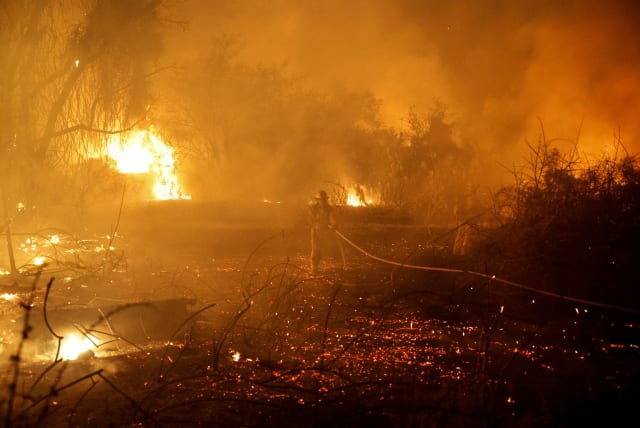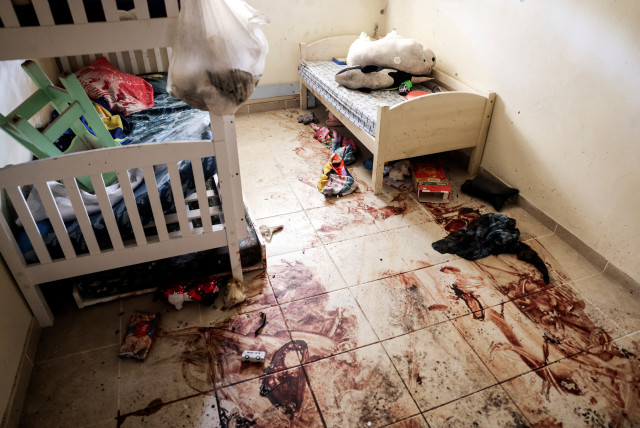Hamas planned to push October 7 massacre to the West Bank border - report

Under Hamas's original plan, it would have hit many other major Israeli cities and IDF bases and go as far as the West Bank, where it has allies in the form of local terrorist cells.
Hamas's original plan for October 7 went beyond just a massacre in the Gaza border area and taking hundreds of hostages, but to continue their assault up to the border with the West Bank, The Washington Post reported Sunday, citing Western and Middle Eastern security officials briefed on collected evidence.
This information was obtained from numerous maps, notes, supplies, and other written instructions found among the bodies of dead Hamas terrorists in the Gaza border area, as well as from interrogations of Hamas captives.
"We know from interrogations that Hamas came in with detailed plans of their attack, including which commander should rape which soldiers in different places," Defense Minister Yoav Gallant explained to The Washington Post, though the quote has since been removed from the original report.
Hamas planned to go much farther into Israel on October 7
On October 7, Hamas terrorists executed a meticulously planned mass infiltration of Israel, under the cover of a heavy rocket bombardment. There, they managed to wreak havoc on at least 22 Israeli towns and military outposts near the Gaza border throughout the day, killing around 1,200 Israelis and abducting hundreds of people to bring back to Gaza as hostages.
The farthest the Hamas terrorists were able to infiltrate was the city of Ofakim in the Western Negev, around halfway between Gaza and the West Bank.
However, according to the Washington Post article, the evidence suggests they were planning on going much farther, hitting major cities and military bases, and could have ended up making it to the West Bank, where Hamas has allies in the form of many local armed Palestinian terrorist cells.
"If that had occurred, it would have been a huge propaganda win — a symbolic blow not only against Israel but also against the Palestinian Authority," a former US security official told The Washington Post under the condition of anonymity.
This also comes as Israel's attention shifted away from Gaza and Hamas – particularly after the last round of fighting in 2021, Operation Guardians of the Wall – towards the West Bank, which had been seeing a dramatic upsurge in violence and terrorism.
This, however, may have allowed Hamas to discreetly and methodically plot its plan over time, training terrorists and gathering intelligence in the utmost secrecy.
"They were conning Israel on a strategic level, using handheld radios, land-wire networks in the tunnels and other comms that we couldn’t listen to, while using codes on the so-called open networks, which they knew we were listening to," former Israeli National Security Council deputy head Eran Etzion said, according to The Washington Post. "They were creating an alternative reality."
The report further said that this would have come at a high cost, with Hamas knowing the level of Israel's response.
"They were very clear-eyed as to what would happen to Gaza on the day after," a senior Israeli military official told the outlet. "They wanted to buy their place in history — a place in the history of jihad — at the expense of the lives of many people in Gaza."
However, while Hamas may have expected this level of Israeli response, the involvement of the US may have come as a surprise.
"An Israeli response? Yes, we expected that," senior Hamas political leadership member Ali Barakeh told The Financial Times in late October. "But what we're seeing now is the entrance of the US into the battle, and this we didn't count on."
Washington diverted many of its forces to the area amid Israel's launching of Operation Swords of Iron, the latest war with Hamas.
Just a day after Hamas's massacre, the US sent a carrier strike group, featuring the world's largest aircraft carrier, the USS Gerald R. Ford, closer to Israel. Later in the month, the US sent Lt.-Gen. James Glynn, a three-star Marine general, and other military officers helped Israel plan its ground offensive into the Gaza Strip.
At the time of writing, Israeli troops have managed to make heavy gains in the northern Gaza Strip, claiming that Hamas has lost control of the area and has encircled Gaza City.
Efforts to free the remaining hostages and eliminate Hamas remain ongoing.
Jerusalem Post Store
`; document.getElementById("linkPremium").innerHTML = cont; var divWithLink = document.getElementById("premium-link"); if (divWithLink !== null && divWithLink !== 'undefined') { divWithLink.style.border = "solid 1px #cb0f3e"; divWithLink.style.textAlign = "center"; divWithLink.style.marginBottom = "15px"; divWithLink.style.marginTop = "15px"; divWithLink.style.width = "100%"; divWithLink.style.backgroundColor = "#122952"; divWithLink.style.color = "#ffffff"; divWithLink.style.lineHeight = "1.5"; } } (function (v, i) { });

